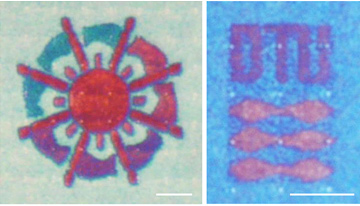 An example of plasmon-assisted laser printing of colored logos (scale bars: 5 µm). This color printing technology is ink-free, economic and scalable, with potential applications from large-scale color printing and decoration, to nanoscale color patterning, to encryption and data storage, where high information densities are sought.
An example of plasmon-assisted laser printing of colored logos (scale bars: 5 µm). This color printing technology is ink-free, economic and scalable, with potential applications from large-scale color printing and decoration, to nanoscale color patterning, to encryption and data storage, where high information densities are sought.
Color appearance and printing are indispensable for identifying and perceiving objects, both in nature and in commercial products. Unfortunately, products based on chemical colorants, such as pigments or dyes, have recycling issues. Structural colors offer an attractive alternative, owing to a reduced number of needed materials and easier recycling potential.
Particularly, color generation by plasmonic metasurfaces has the advantages of ultra-small volume, subwavelength spatial resolution and the simultaneous production of bright non-fade colors.1 However, plasmonic color pixels have so far been pre-designed and “printed” using e-beam lithography, which creates a challenge in scaling up, maintaining low costs, and customizing products.2
As a new paradigm, we propose simply to print the final pattern using an ink-free portable laser printer on a generic, mass-producible plasmonic substrate made by nanoimprinting.3,4 Pulsed-laser irradiation generates transient thermal power in these plasmonic metasurfaces that melts and reshapes structures. Depending on the laser pulse energy density, different surface morphologies arise. These support plasmonic resonances, with the electron gas oscillating at different visible frequencies, which in turn lead to different apparent colors.
By exploring the ultimate advantages of thermo-plasmonics, we have demonstrated full-color laser printing on plasmonic metasurfaces with sub-diffraction-limit resolution. The nanoimprinted metasurfaces are composed of a 20-nm aluminium film buried in a thin-film polymer that is flexible, economic and recyclable.
Reconfigured by plasmon resonances, our laser printing process allows for recording speeds up to 1 Gbit s–1, with a pulse energy down to 0.3 nJ. Colors are printed when laser heating modifies a single unit cell. The 200×200-nm individual pixel size enables color laser printing with a resolution up to 127,000 dots per inch.5
As a result of this technology and methodology, we can print color logos with features as small as 200 nm using a palm-sized laser. These prints, we believe, are candidates for the smallest laser-printed figures in the world.
Researchers
Xiaolong Zhu, Christoph Vannahme, Emil Højlund-Nielsen, N. Asger Mortensen and Anders Kristensen, Technical University of Denmark, Kongens Lyngby, Denmark
References
1. N. Dean. Nat. Nanotechnol. 10, 15 (2015).
2. K. Kumar et al. Nat. Nanotech. 7, 557 (2012).
3. J.S. Clausen et al. Nano Lett. 14, 4499 (2014).
4. E. Højlund-Nielsen et al. Adv. Mater. Technol.
1, 1600054 (2016).
5. X. Zhu et al. Nat. Nanotech. 11, 325 (2016).
